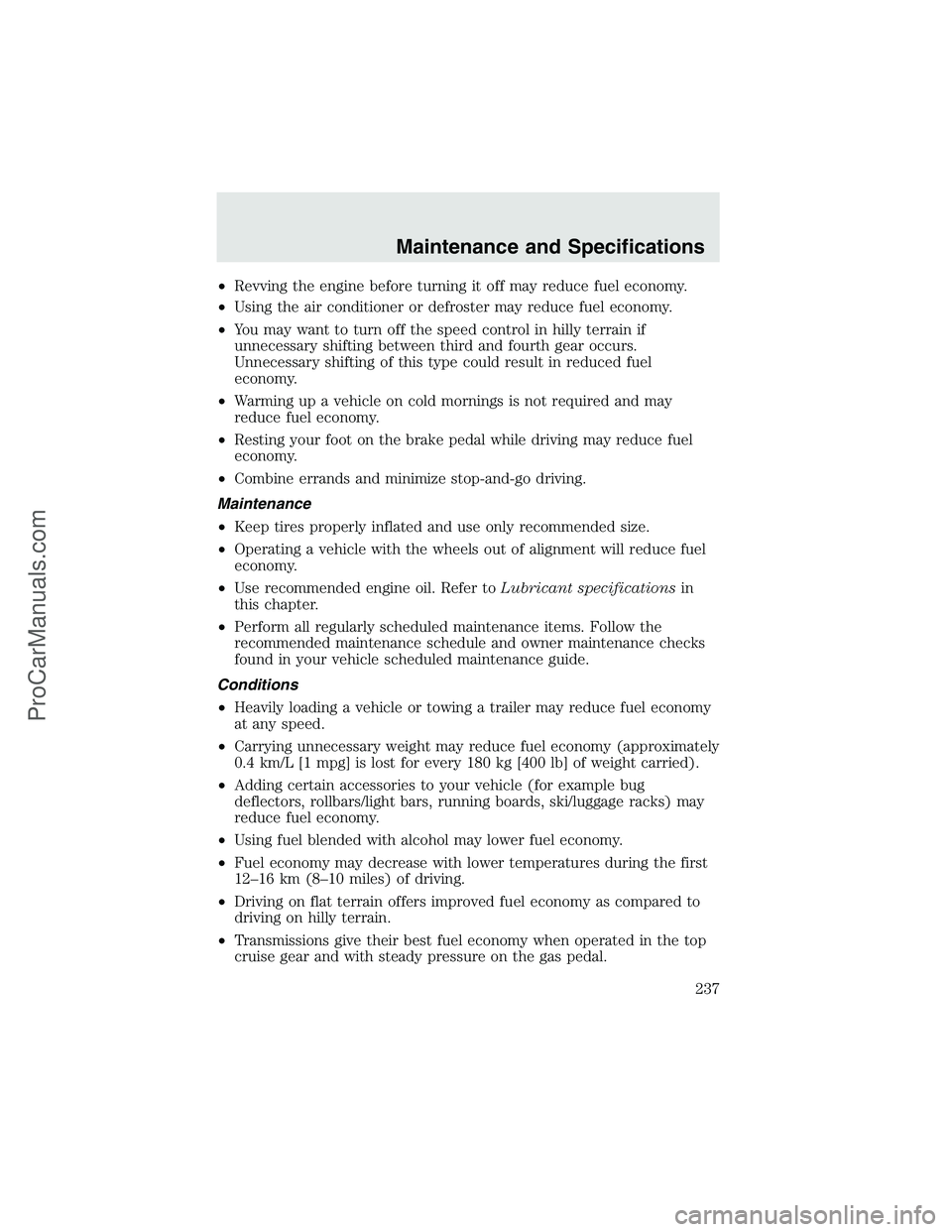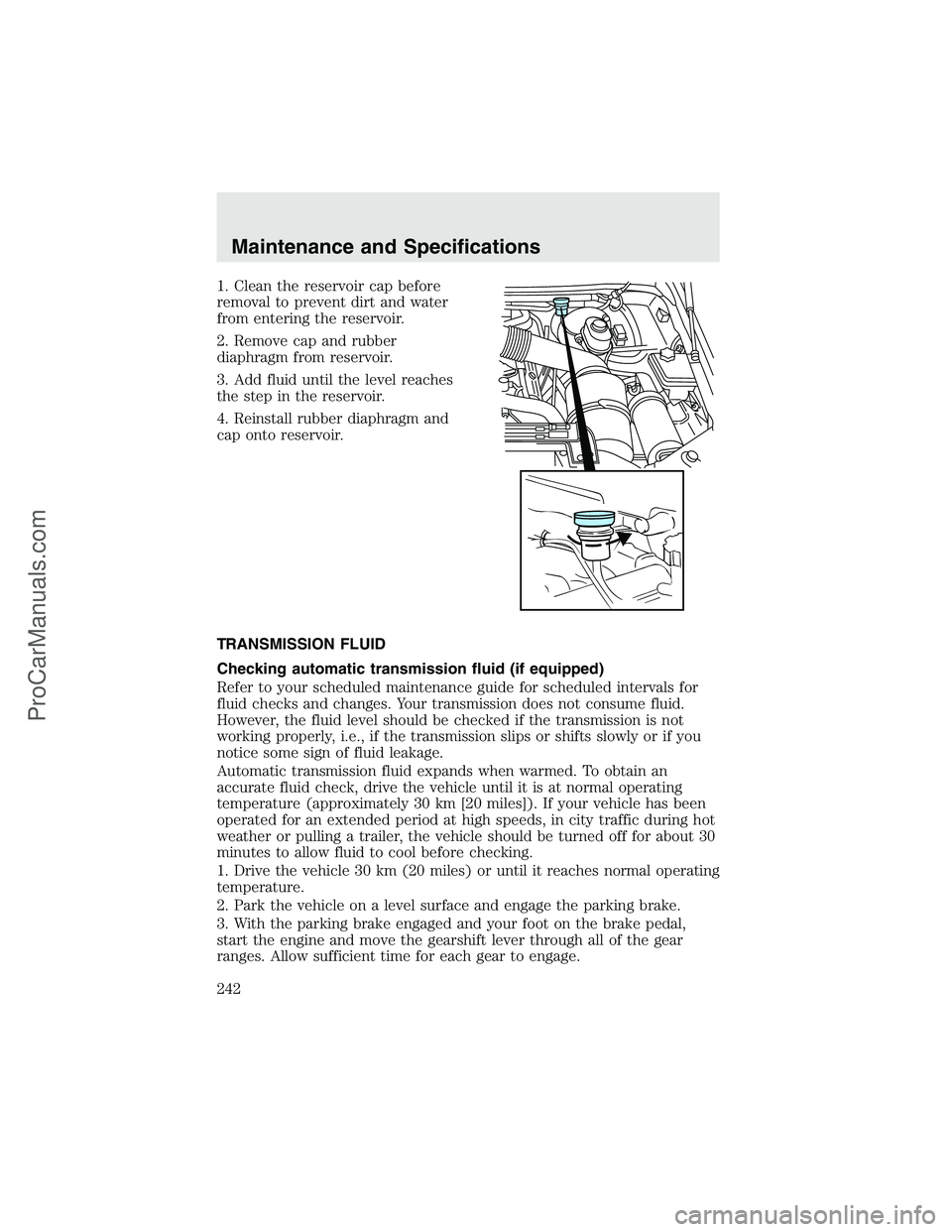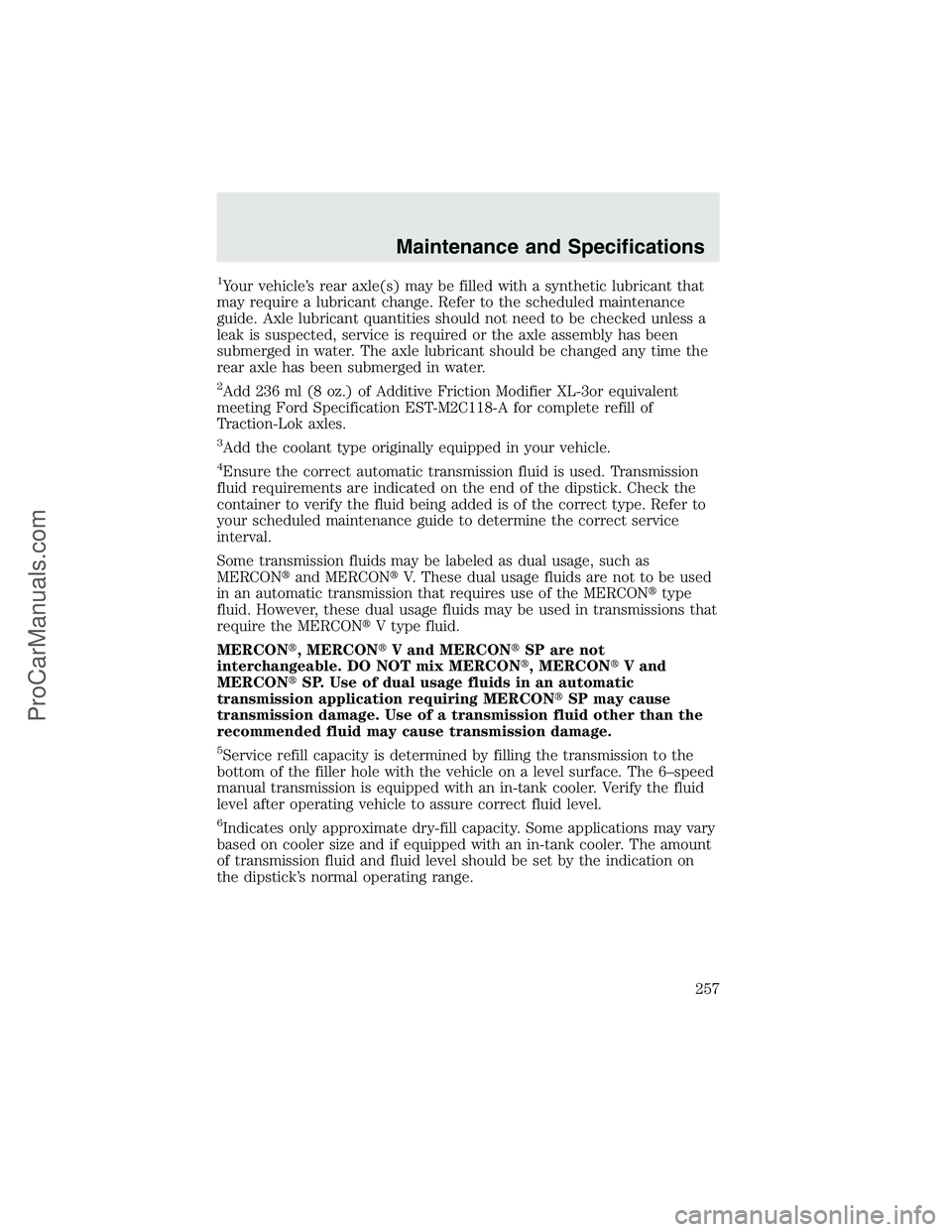Page 237 of 280

•Revving the engine before turning it off may reduce fuel economy.
•Using the air conditioner or defroster may reduce fuel economy.
•You may want to turn off the speed control in hilly terrain if
unnecessary shifting between third and fourth gear occurs.
Unnecessary shifting of this type could result in reduced fuel
economy.
•Warming up a vehicle on cold mornings is not required and may
reduce fuel economy.
•Resting your foot on the brake pedal while driving may reduce fuel
economy.
•Combine errands and minimize stop-and-go driving.
Maintenance
•Keep tires properly inflated and use only recommended size.
•Operating a vehicle with the wheels out of alignment will reduce fuel
economy.
•Use recommended engine oil. Refer toLubricant specificationsin
this chapter.
•Perform all regularly scheduled maintenance items. Follow the
recommended maintenance schedule and owner maintenance checks
found in your vehicle scheduled maintenance guide.
Conditions
•Heavily loading a vehicle or towing a trailer may reduce fuel economy
at any speed.
•Carrying unnecessary weight may reduce fuel economy (approximately
0.4 km/L [1 mpg] is lost for every 180 kg [400 lb] of weight carried).
•Adding certain accessories to your vehicle (for example bug
deflectors, rollbars/light bars, running boards, ski/luggage racks) may
reduce fuel economy.
•Using fuel blended with alcohol may lower fuel economy.
•Fuel economy may decrease with lower temperatures during the first
12–16 km (8–10 miles) of driving.
•Driving on flat terrain offers improved fuel economy as compared to
driving on hilly terrain.
•Transmissions give their best fuel economy when operated in the top
cruise gear and with steady pressure on the gas pedal.
Maintenance and Specifications
237
ProCarManuals.com
Page 242 of 280

1. Clean the reservoir cap before
removal to prevent dirt and water
from entering the reservoir.
2. Remove cap and rubber
diaphragm from reservoir.
3. Add fluid until the level reaches
the step in the reservoir.
4. Reinstall rubber diaphragm and
cap onto reservoir.
TRANSMISSION FLUID
Checking automatic transmission fluid (if equipped)
Refer to your scheduled maintenance guide for scheduled intervals for
fluid checks and changes. Your transmission does not consume fluid.
However, the fluid level should be checked if the transmission is not
working properly, i.e., if the transmission slips or shifts slowly or if you
notice some sign of fluid leakage.
Automatic transmission fluid expands when warmed. To obtain an
accurate fluid check, drive the vehicle until it is at normal operating
temperature (approximately 30 km [20 miles]). If your vehicle has been
operated for an extended period at high speeds, in city traffic during hot
weather or pulling a trailer, the vehicle should be turned off for about 30
minutes to allow fluid to cool before checking.
1. Drive the vehicle 30 km (20 miles) or until it reaches normal operating
temperature.
2. Park the vehicle on a level surface and engage the parking brake.
3. With the parking brake engaged and your foot on the brake pedal,
start the engine and move the gearshift lever through all of the gear
ranges. Allow sufficient time for each gear to engage.
Maintenance and Specifications
242
ProCarManuals.com
Page 243 of 280

4. Latch the gearshift lever in P (Park) and leave the engine running.
5. Remove the dipstick, wiping it clean with a clean, dry lint free rag. If
necessary, refer toIdentifying components in the engine compartment
in this chapter for the location of the dipstick.
6. Install the dipstick making sure it is fully seated in the filler tube.
7. Remove the dipstick and inspect the fluid level. The fluid should be in
the designated area for normal operating temperature or ambient
temperature.
Low fluid level
Do not drive the vehicle if the fluid
level is at the bottom of the dipstick
and the ambient temperature is
above 10°C (50°F).
Correct fluid level
The transmission fluid should be checked at normal operating
temperature 66°C-77°C (150°F-170°F) on a level surface. The normal
operating temperature can be reached after approximately 30 km (20
miles) of driving.
You can check the fluid without driving if the ambient temperature is
above 10°C (50°F). However, if fluid is added at this time, an overfill
condition could result when the vehicle reaches normal operating
temperature.
The transmission fluid should be in
this range if at normal operating
temperature (66°C-77°C
[150°F-170°F]).
The transmission fluid should be in
this range if at ambient temperature
(10°C-35°C [50°F-95°F]).
High fluid level
Fluid levels above the safe range
may result in transmission failure.
An overfill condition of transmission
fluid may cause shift and/or
engagement concerns and/or possible damage.
High fluid levels can be caused by an overheating condition.
ADD COLD HOT DO NOT ADD
ADD COLD HOT DO NOT ADD
ADD COLD HOT DO NOT ADD
ADD COLD HOT DO NOT ADD
Maintenance and Specifications
243
ProCarManuals.com
Page 244 of 280

Adjusting automatic transmission fluid levels
Before adding any fluid, make sure the correct type is used. The type of
fluid used is normally indicated on the dipstick and also in the
Lubricant specificationssection in this chapter.
Use of a non-approved automatic transmission fluid may cause
internal transmission component damage.
If necessary, add fluid in 250 ml (1/2 pint) increments through the filler
tube until the level is correct.
If an overfill occurs, excess fluid
should be removed by a qualified
technician.
An overfill condition of
transmission fluid may cause shift and/or engagement concerns
and/or possible damage.
Do not use supplemental transmission fluid additives, treatments or
cleaning agents. The use of these materials may affect transmission
operation and result in damage to internal transmission components.
Automatic transmission fluid filter (if equipped)
The TorqShift automatic
transmission is equipped with a
serviceable external fluid filter
mounted on the frame rail. Refer to
the Scheduled Maintenance Guide
for service intervals.
ADD COLD HOT DO NOT ADD
Maintenance and Specifications
244
ProCarManuals.com
Page 245 of 280
Checking and adding manual transmission fluid (if equipped)
1. Clean the filler plug.
2. Remove the filler plug and
inspect the fluid level.
3. Fluid level should be at the
bottom of the opening.
4. Add enough fluid through the
filler opening so that the fluid level
is at the bottom of the opening.
5. Install and tighten the fill plug
securely.
Use only fluid that meets Ford specifications. Refer toLubricant
Specificationsin this chapter.
Maintenance and Specifications
245
ProCarManuals.com
Page 254 of 280
MOTORCRAFT PART NUMBERS
Component* 5.4L V8 engine 6.8L V10 engine
Air filter element FA-1634 FA-1634
Fuel filter FG-986B FG-986B
Oil filter FL-820-S FL-820-S
PCV valve EV-233 EV-233
Battery (Standard) BXT-65-650 BXT-65-650
Battery (Optional) BXT-65-750 BXT-65-750
Spark plugs-platinum** AGSF-22W AGSF-22W
Automatic Transmission
Filter ***——
*Refer to the6.0 Liter Power Stroke Direct Injection Turbo Diesel
Owner’s Guide Supplementfor Motorcraft diesel engine service part
numbers.
**Refer to Vehicle Emissions Control Information (VECI) decal for spark
plug gap information.
***Only available with 6.0L Diesel engine/TorqShift transmission. Part
number is FT-145.
REFILL CAPACITIES
FluidFord Part
NameApplication Capacity
Front axle Hypoid Gear Oil
SAE 90F-250/350
(Dana 60 axle)2.7L (5.8 pints)
F-350/450/550
(Dana 60 axle)2.7L (5.8 pints)
Maintenance and Specifications
254
ProCarManuals.com
Page 256 of 280
FluidFord Part
NameApplication Capacity
Fuel tank N/A Mid-ship tank
(optional on
Chassis Cab)71.9L (19.0
gallons)
Right side
saddle mounted
tank (optional
on Chassis Cab)87.1L (23.0
gallons)
Short box 109.8L (29.0
gallons)
Long box 143.9L (38.0
gallons)
Aft axle 151.4L (40.0
gallons)
Power steering
fluidMotorcraft
MERCON�AT FAll Fill to FULL
COLD range on
dipstick
Transfer case
fluidMotorcraft
MERCON�AT F4x4 vehicles 1.9L (2.0
quarts)
Manual
transmission
fluidMotorcraft
MERCON�AT F6-speed manual 5.5L (5.8
quarts)
5
Automatic
transmission
fluid
4
Motorcraft
MERCON�AT F4R100
(4–speed)16.7L (17.7
quarts)6
Motorcraft
MERCON�SP
AT FTorqShift
(5–speed)16.6L (17.5
quarts)
6(includes
remote filter
element change)
Windshield
washer fluidMotorcraft
Premium
Windshield
Washer
ConcentrateAll 4.0L (4.25
quarts)
Maintenance and Specifications
256
ProCarManuals.com
Page 257 of 280

1Your vehicle’s rear axle(s) may be filled with a synthetic lubricant that
may require a lubricant change. Refer to the scheduled maintenance
guide. Axle lubricant quantities should not need to be checked unless a
leak is suspected, service is required or the axle assembly has been
submerged in water. The axle lubricant should be changed any time the
rear axle has been submerged in water.
2Add 236 ml (8 oz.) of Additive Friction Modifier XL-3or equivalent
meeting Ford Specification EST-M2C118-A for complete refill of
Traction-Lok axles.
3Add the coolant type originally equipped in your vehicle.
4Ensure the correct automatic transmission fluid is used. Transmission
fluid requirements are indicated on the end of the dipstick. Check the
container to verify the fluid being added is of the correct type. Refer to
your scheduled maintenance guide to determine the correct service
interval.
Some transmission fluids may be labeled as dual usage, such as
MERCON�and MERCON�V. These dual usage fluids are not to be used
in an automatic transmission that requires use of the MERCON�type
fluid. However, these dual usage fluids may be used in transmissions that
require the MERCON�V type fluid.
MERCON�, MERCON�V and MERCON�SP are not
interchangeable. DO NOT mix MERCON�, MERCON�V and
MERCON�SP. Use of dual usage fluids in an automatic
transmission application requiring MERCON�SP may cause
transmission damage. Use of a transmission fluid other than the
recommended fluid may cause transmission damage.
5Service refill capacity is determined by filling the transmission to the
bottom of the filler hole with the vehicle on a level surface. The 6–speed
manual transmission is equipped with an in-tank cooler. Verify the fluid
level after operating vehicle to assure correct fluid level.
6Indicates only approximate dry-fill capacity. Some applications may vary
based on cooler size and if equipped with an in-tank cooler. The amount
of transmission fluid and fluid level should be set by the indication on
the dipstick’s normal operating range.
Maintenance and Specifications
257
ProCarManuals.com